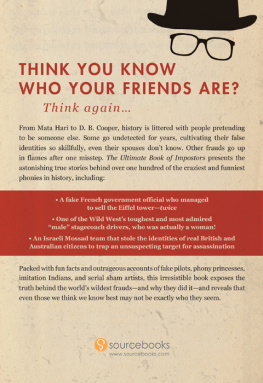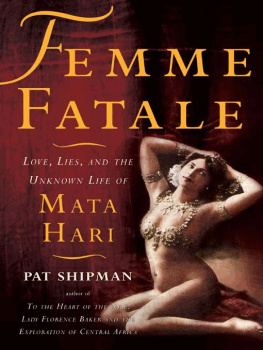
Copyright 2013 by Ian Graham
Cover and internal design 2013 by Sourcebooks, Inc.
Cover design and illustrations by Arthur Cherry
Sourcebooks and the colophon are registered trademarks of Sourcebooks, Inc.
All rights reserved. No part of this book may be reproduced in any form or by any electronic or mechanical means including information storage and retrieval systemsexcept in the case of brief quotations embodied in critical articles or reviewswithout permission in writing from its publisher, Sourcebooks, Inc.
This publication is designed to provide accurate and authoritative information in regard to the subject matter covered. It is sold with the understanding that the publisher is not engaged in rendering legal, accounting, or other professional service. If legal advice or other expert assistance is required, the services of a competent professional person should be sought. From a Declaration of Principles Jointly Adopted by a Committee of the American Bar Association and a Committee of Publishers and Associations
All brand names and product names used in this book are trademarks, registered trademarks, or trade names of their respective holders. Sourcebooks, Inc., is not associated with any product or vendor in this book.
Published by Sourcebooks, Inc.
P.O. Box 4410, Naperville, Illinois 60567-4410
(630) 961-3900
Fax: (630) 961-2168
www.sourcebooks.com
Library of Congress Cataloging-in-Publication Data
Graham, Ian.
The ultimate book of impostors : over 100 true stories of the greatest phonies and frauds / Ian Graham.
pages cm
Includes bibliographical references and index.
(pbk. : alk. paper) 1. Impostors and imposture--History. I. Title.
HV6751.G73 2013
364.16'3--dc23
2013031145
To Ormeau Road public library in Belfast,
Northern Ireland, where I learned to love books.
CONTENTS

That is indeed the question. When I was a youngster, I was a sucker for horror stories. One that stayed with me is The Ohio Love Sculpture by Adobe James. In just seven pages it tells the story of an art collector who stumbles across the most magnificent sculpture he has ever seenthree reclining nudes. He has to have it. He offers more and more money, but the stubborn sculptor wont sell. Eventually the collector manages to trick the sculptor into giving up his stunning creation. But before he can pick it up, the sculptor is involved in an incident that brings the police to his home, where they make a chilling discovery:
The artist isnt a sculptor, hes a taxidermist!
This story sowed the seed in my mind at a young age that people are not always what they seem. Decades later, this same idea led me to write this book. The idea of mistaken or deliberately falsified identity is common in fiction, but you dont have to go to the trouble of dreaming up fictitious impostors. As youll see in this book, there is no shortage of the real thing. History is littered with examples of people who pretended to be someone else.
You may wonder why on earth so many people would risk so muchtheir lives, families, careers, freedomsimply to put on a different face. In most cases, their various motivations can be boiled down to just four things, the four Es:
Envy of other peoples wealth or social status has driven many impostors to claim to be the heir to a kingdom or an aristocratic title. This was especially easy in past times: before DNA testing and photo IDs, how would you know whether someone really was the Earl of this or Duke of that, or a royal prince? A pretender with the right fashion credentials and a regal bearing, coupled with the gift of the gab and bags of confidence, was indistinguishable from the real thing to most people. Add the support of a Machiavellian manipulator, such as a kingmaker, and youre a winner. At least, you hope youre a winner. Many a pretender who failed to convince those more powerful than he ended his days at the point of a sword or in the merciless hands of an executioner. For example, when a woman who pretended to be Margaret, Maid of Norway and daughter of King Erik II of Norway, in the thirteenth century was exposed as an impostor, she was burned at the stake and her husband was beheaded!
Since then, envy of wealth for its own sake has driven some criminals to use fake identities to steal large sums of money or valuable property. Most of them are known for one false identity, but a few are serial impostors who moved seamlessly from one identity to another to suit their needs.
Fantasists boost their ego by becoming someone else with a more interesting, exciting, or exotic life than their own. They seek attention and approval. This group includes the bogus pilots, spies, and war heroes whose false identities command respect and admiration. And of course one of the quickest and easiest ways to escape from the consequences of crime is to adopt a false identity.
At times when there was no such thing as social mobility, some people tried to escape the limits of the class they were born into by becoming someone else. Others escaped the social straitjacket of their time by switching gender, usually from female to male. Women with an ambition to serve as a soldier or sailor in past centuries could do so only by appearing to be men. Some of them served for years without being found out.
Some people have adopted false identities perfectly legally. They are the undercover police officers and secret service agents who infiltrate groups for the purposes of surveillance or espionage. Deep-cover agents sometimes live for years under a false identity, gathering intelligence for law enforcement and national defense agencies.
Beyond these four reasons, there are numerous other motives for wanting to adopt a false identity. For instance, a handful of professional entertainers created a stage persona so successful and so convincing that they started living the role offstage too. Their fans got a shock when the truth of these entertainers lives was revealed after death.
In most cases, impostors adopt fictitious false identities, but sometimes they steal the identities of real people, alive or dead. Stealing a real persons identity has advantagesthey have a real life history with facts that can be verified by anyone who gets suspicious. However, one obvious disadvantage is that if the real person is still alive, he or she may turn up and expose the impostor. One way to get around this is to steal the identity of someone who has died. This was the method used by the assassin in Frederick Forsyths book, The Day of the Jackal to obtain a birth certificate, which he used to apply for a passport in the dead boys name. But of course anyone who takes the trouble to investigate the impostor is likely to discover evidence of the death. Two real impostors who copied this method were discovered when background checks revealed that they had died years earlier!
You might think imposture would be virtually impossible today, with our photo-ID, online credit checks, official certificates and licenses, fingerprints and DNA databases to confirm identity. However, the very existence of some of this identity documentation can actually make it more difficult to detect an impostor. Convincing forgeries of official certificates are sometimes taken at face value and no other checks are made. Bogus pilots and doctors continue to foil lax authorities by using fake documents.
The dictionary definition of
Next page















